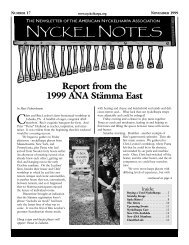Nyckel Notes #1, Oct 1995 - American Nyckelharpa Association
Nyckel Notes #1, Oct 1995 - American Nyckelharpa Association
Nyckel Notes #1, Oct 1995 - American Nyckelharpa Association
You also want an ePaper? Increase the reach of your titles
YUMPU automatically turns print PDFs into web optimized ePapers that Google loves.
<strong>Nyckel</strong> <strong>Notes</strong> <strong>Oct</strong> <strong>1995</strong> 3<br />
Spela Bättre!<br />
(The Only Way to Improve Your Playing)<br />
by Matt Fichtenbaum<br />
This style of teaching is a new experience for me.<br />
I’m used to working one-on-one, when I can see<br />
and hear what a player is doing and offer some<br />
hints or suggest some appropriate exercises that<br />
can help develop his or her playing. Now you’re out<br />
there reading this - I don’t know who you are, how<br />
long you’ve been playing, what you’d like to be able<br />
to do. So this time I’ll touch on some of the basics<br />
of playing nyckelharpa; future articles might look in<br />
more depth at one or two specific topics.<br />
For me, the art of playing nyckelharpa breaks down<br />
into expression, style, and technique. Expression is<br />
what you’re "saying" when you play a tune, and what<br />
you want a listener to feel - joy, melancholy, tension,<br />
an inability to sit still. Style is what makes a tune<br />
sound "traditional," or distinguishes it from the way<br />
you’d play the same tune on a fiddle, or makes<br />
Ceylon Wallin’s playing different from Olov<br />
Johansson’s. And technique is how you work the<br />
tools - the left hand and the right hand, the bow, the<br />
keys - so that the instrument does what you want it<br />
to. If there were a "structured model" of playing<br />
nyckelharpa, technique would be at the base, so<br />
that’s a good place to start.<br />
Holding the harpa<br />
No doubt you know that the harpa hangs around<br />
your neck on a strap, and the strap goes in front of<br />
both shoulders. Then the right upper arm rests on<br />
the tailpiece, holding the instrument in position.<br />
Many players like to position their instruments<br />
horizontal, or with the keybox slightly higher, with<br />
the bridge is slightly to the left of center so that,<br />
looking down at it, they see its lower (tailpiece-side)<br />
surface. Perhaps the most important point is that<br />
the left hand does not support the instrument: it<br />
must be relaxed, free to move around and play the<br />
keys.<br />
The first step, then, is to get the left hand (a) into a<br />
comfortable position on the keys, and (b) so that the<br />
fingers know where they need to be. In his<br />
excellent work "Spela <strong>Nyckel</strong>harpa," Vol. 1, Leif<br />
Alpsjö describes the proper left hand position. The<br />
fingers are lightly curved and touch the keys with<br />
the tips; the thumb is bent under, parallel to the<br />
palm, and slides along the neck at the base of the<br />
bottom key row. Remember that the left hand plays<br />
no role in supporting the instrument.<br />
Then the fingers must learn where they belong.<br />
Play the first five notes of a scale, starting on the<br />
open A string. The keys you use are 0 (open), 2, 4,<br />
5, 7. Use all four fingers, in order. Play it again.<br />
Try the same keys on the C string - it's a scale<br />
starting on the note C. Likewise on the G string.<br />
The intervals - the pattern of musical steps - are the<br />
same, so the scale sounds the same, just in a<br />
different key. Now play a full eight-note scale<br />
starting on the C string: C0, 2, 4, 5, 7, A0, 2, 3. Play<br />
it upwards, then downwards, a few times.<br />
Why? Because, simply speaking, tunes use the<br />
notes of the scale. If the fingers know how to find<br />
those notes, the notes will be there when needed<br />
and playing tunes will be a lot less work.<br />
Now play the phrase C0, 4, 7, A3, C7, 4, 0. Use the<br />
same fingers, for each key, that you used in playing<br />
the scale. The notes are C, E, G, and C an octave<br />
higher, the notes of a C major chord. Played in<br />
sequence like this, they're called an arpeggio, an<br />
Italian word meaning "like a harp would play it."<br />
Scales and arpeggios are the basic building blocks<br />
of t(i)3(nge-6(ds)-8(, a f)-es)-8tav di'r8(,cs)-8(t)-1(valu(e es)-8(eox<br />
The left hand<br />
So many keys, so few fingers. But it’s not quite that<br />
bad. First, although the musical octave has twelve<br />
distinct notes (say, from the open A string up to, but<br />
not including, the A, 12 keys up), the musical scale<br />
has only seven. Second, there’s more than one<br />
string on which to play a tune, so oftentimes the<br />
fingers can just move from string to string (er, from<br />
one key row to the next) rather than wildly up and<br />
down the keybox.
















